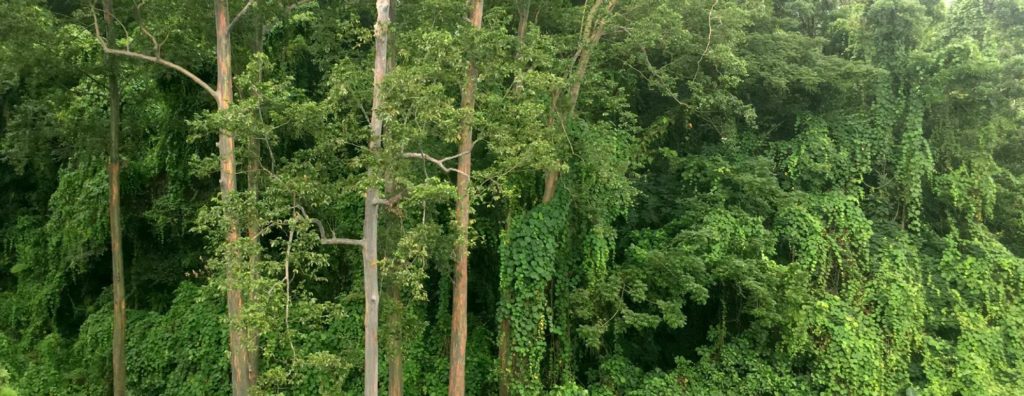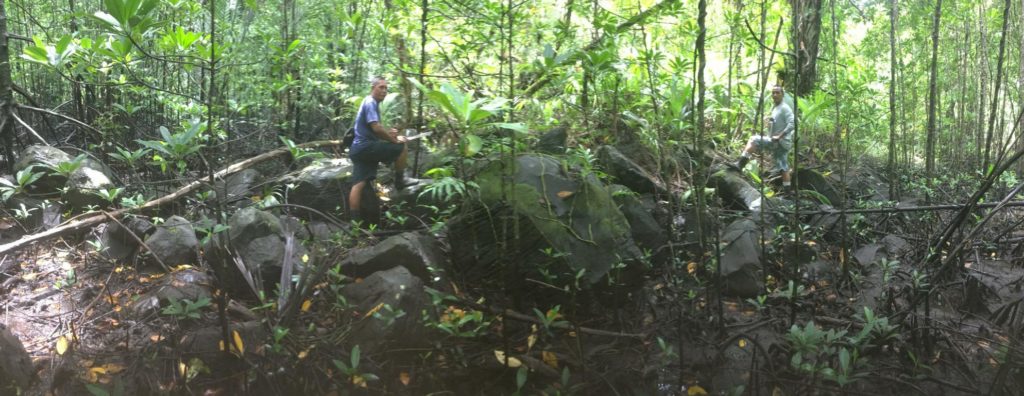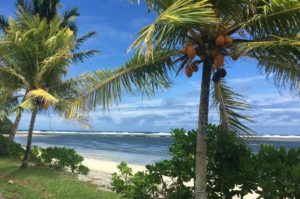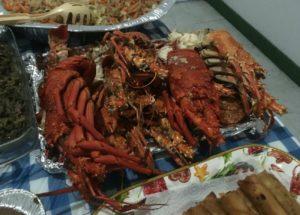Third Month in Paradise
My apartment balcony faces south. To my right is a dense jungle covering the steep slopes of an extinct volcano. To my left are mangroves, a lagoon and a reef where the surf crashes hour after hour, day and night. With the passage of time and the movement of the constellations, the Southern Cross is now visible just after sunset. In the evenings, I stand on my balcony to cool off in the tradewinds and gaze at the Southern Cross blazing over the coconut palms .
Today, I’d like to give you a virtual tour of Kosrae — this beautiful little island that has become my home. As always, click on any photo to enlarge it.
Kosrae is small. With good shoes, a bicycle and a kayak, you can circumnavigate the whole island in a day. Along the way, you’ll pass pristine coral-sand beaches like the ones shown here. You’ll need a kayak to paddle around the mangrove swamps where there are no roads or paths.

Along the shore, the sea is calm because of a fringing reef about 150 meters offshore. The reef absorbs the Pacific’s energy and keeps our lagoon comfortable for swimming and fishing.

Between the shore and the fringing reef is a shallow reef flat. On this reef flat, clusters of mangroves take root. These mangroves are essential to Kosrae’s survival in this era of rising sea levels. The mangroves absorb any surf that comes over the reef. By filtering the sediments and organic matter from the island, the mangroves keep the reef clean and healthy. The mangroves also provide environments for fish and crabs.

Except for a few small passages through which fishing boats can come and go, the fringing reef encircles the entire island, The surf beyond the reef is 1 to 2 meters high.

In some places, the mangroves are so thick that they form a continuous barrier between the shore and the reef. This creates estuaries that are full of birds and other wildlife. The estuaries are wonderful places to explore by kayak.

Most of Kosrae is forested. Without a machete, you won’t go far into this vegetation. Even after you’ve cut a path through this jungle, you may not be able to find your path a week later because the undergrowth will have grown back very fast. Many of the trees are blanketed by a flowering vine that I first thought was Kudzu. It’s actually Merremia peltata, a member of the morning glory family.
Kosrae’s interior is very steep. So, all of Kosrae’s 6600 residents live on the flats near the shore. This leaves the interior of the island undeveloped, unspoiled and natural,
Here’s the wacky group that I work with at Kosrae’s Historic Preservation Office. Today, we’re hacking our way through a mangrove swamp in search of 1000-year-old ruins built by some of the first kings of Kosrae. When this photo was taken, we were searching for a palace known as Likinlulem, where Kosrae’s first chiefs are said to have held court. The site is an important element of the island’s oral history.

The photos above shows what a 1000-year-old ruin looks like when it has been overtaken by Korsae’s jungle. It doesn’t look like much. After some reconnoitering, we concluded that these basalt boulders were once a pier.
My friends and I sometimes go fishing. There’s lots to eat in the reefs. I can’t claim to have caught these lobsters, but they sure were delicious!

Tropical sunsets are lovely. Sometimes I sit on the beach with a beer and watch the sky go pink in the evening. In these times of Coronavirus, you can see why I’m not in a hurry to leave Kosrae — which is still 100% virus-free.
Eventually, international travel will become smooth again and I’ll get restless. Even today, United Airlines announced an “evacuation flight.” Because Micronesia’s international travel ban is still enforced, this flight is for outbound travelers only. No one will be allowed to deplane in Kosrae. So, like Shangri-La, if I leave this paradise, I can’t come back. I think I’ll stay here for a while longer.




Nice Nick, keep it coming. We can use the uplift!
Hi, Nick. Maciej here. Oh… The Southern Cross 🙂 I remember the night before Total Solar Eclipse in 2016 at Ternate. I hope you have a lot adventures since then.
Best regards
You are so very lucky to be in that paradise and have interesting things to do, leisure time, and the internet. I have been “stranded” the same amount of time in Shingal, Iraq, an area that was destroyed by ISIS then Coalition air strikes. No one has removed the concrete rubble of buildings nor rebuilt. We are locked down here. The border to Kurdistan, northern Iraq will reopen June 1 along with the airport.
PS: Did you find the palace?
After much bushwhacking, we found the servants’ quarters. We’ll go back again today to see if we can find the main structure.
Don’t leave.
Marvin
I am in Nashville and I often think of you when I am outside at night. I see the stars, what few shine through the city night sky, and wonder which ones you’re seeing. When the moon was full, a few days (week?) ago, there were two stars (planets?) lined up right next to it. “Right next” being an unscientific term. Pretty much nothing else in the sky but the moon and these two stars. One seemed a bit reddish and I wondered if it were Mars. I knew you’d know. Wished you’d been in my driveway to tell me about it, and I wished I were with you on Kosrae.
Love the photo of the horizontal palm tree over the ocean. Really an attention grabber.
The two “stars” next to the moon last week were Jupiter and Saturn. They were brilliant, weren’t they!
Yo Nick,
Jerry here in Nashville—your brother just turned me on to this,
Reminds me of the Grenadines where we sailed our boat AREA 51
“In truth we are always present: we only imagine to be in one place or another”
Be well and enjoy
If only you could paint, you would be a modern-day Gauguin! Nice pictures.
Les jours s’en vont, je demeure.
– Guillaume Apollinaire
Glad to see you’re enjoying yourself. We’re all still in lock-down, with some situations opening up,
Wow too fascinating my friend Nick to see the sites of the nation where you are in.
you are lucky having been there for your enjoyment and tour.
Wishing you the best in your life.
Really enjoy your descriptions of the earth, sea and sky.
To go around the island via walking, bike and kayak, do you have to carry the kayak? What about when you’re on your bike? I guess the part east of the airport is the most difficult.
You can rent or borrow a kayak from someone who will collect it when you’re done, even if you drop it off at a different location. Same with the bicycle. And yes, the north side of Kosrae, east of the airport, is all mangroves. Not even a footpath goes through there. To get past there, you kayak inside the reef, so the water is flat.
I remember the first time I clearly saw the Southern Cross. I was in the outback of Australia near Alice Springs. It is such an interesting constellation for those of us here in the Northern Hemisphere. Here on the farm we are lucky also as we can move about without contacting anyone or fear of contracting anything. Once every week or two we wonder off the property for some of the basics but other than that life is fairly normal. This will likely be the first year in over a decade when no new stamps will be added to my passport. Though I cant travel I can read your postings and learn about places that I will visit sometime in the future. Be safe and keep in touch. In friendship, David.
Nick, I am loving the deja by. Your
sense of discovery and wonder and delight is palpable. When I was PCV in 1960’s I explored the rugged jungle interior, walked/canoed around the entire island, followed streams inland until the going was just too tough to go any farther, topped out on Mt. Finkol, fell asleep and awoke the next day to the constant tumble of the surf, marveled at the clear night sky. You bring it all back. I can smell the jungle, smell the sea, hear the waves.
Beer was discouraged in those days. The l’eau de vie was well-sugared coffee, which I drank in many a home, sitting on pandamas mats, swapping stories with Kosrae neighbors.
You bring it all back- a gift, for which I am grateful.
I play CSN often, to listen to Southern Cross.
I have some questions about life now compared to life over 50 years ago – and will send those along later.
For now, I can feel that warm breeze coming in off the reef.
Keep on your Keepin on.
Arlena wo!
Doug
🙂